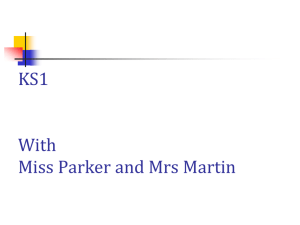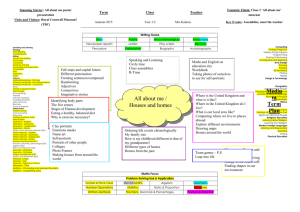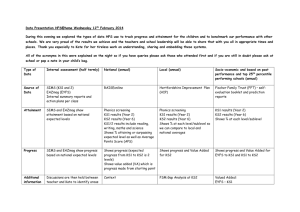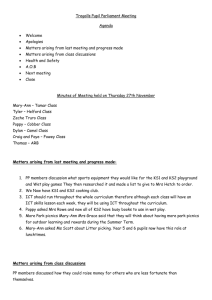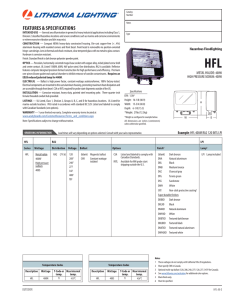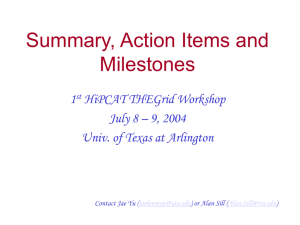Assessment Update - Hertfordshire Grid for Learning
advertisement
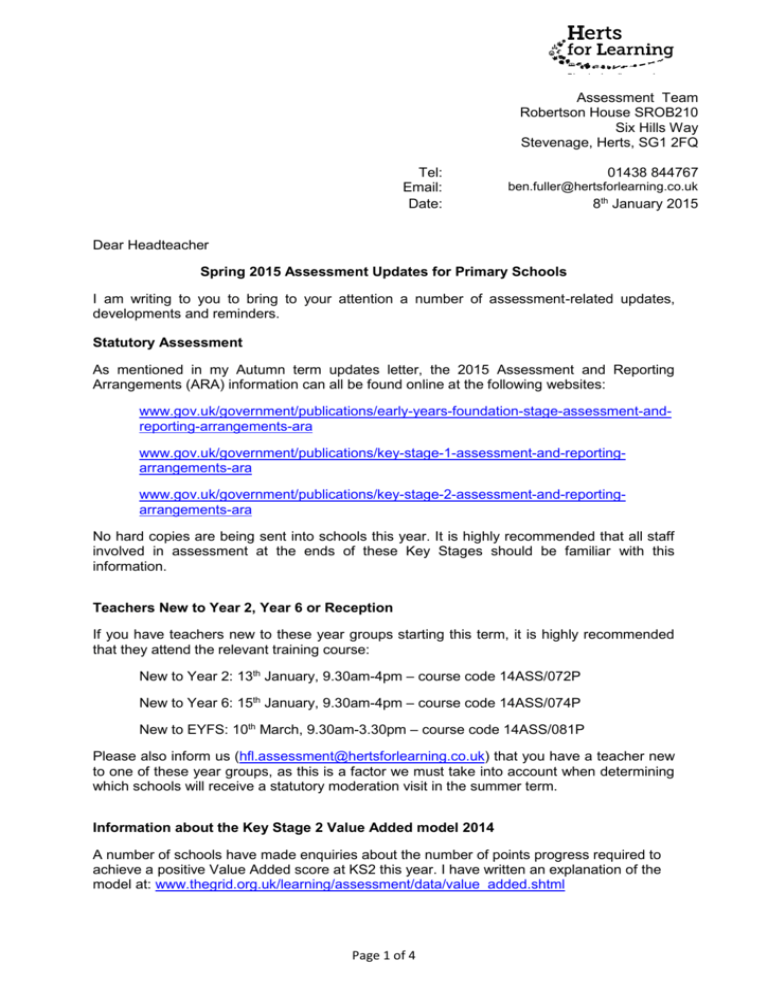
Assessment Team Robertson House SROB210 Six Hills Way Stevenage, Herts, SG1 2FQ Tel: Email: Date: 01438 844767 ben.fuller@hertsforlearning.co.uk 8th January 2015 Dear Headteacher Spring 2015 Assessment Updates for Primary Schools I am writing to you to bring to your attention a number of assessment-related updates, developments and reminders. Statutory Assessment As mentioned in my Autumn term updates letter, the 2015 Assessment and Reporting Arrangements (ARA) information can all be found online at the following websites: www.gov.uk/government/publications/early-years-foundation-stage-assessment-andreporting-arrangements-ara www.gov.uk/government/publications/key-stage-1-assessment-and-reportingarrangements-ara www.gov.uk/government/publications/key-stage-2-assessment-and-reportingarrangements-ara No hard copies are being sent into schools this year. It is highly recommended that all staff involved in assessment at the ends of these Key Stages should be familiar with this information. Teachers New to Year 2, Year 6 or Reception If you have teachers new to these year groups starting this term, it is highly recommended that they attend the relevant training course: New to Year 2: 13th January, 9.30am-4pm – course code 14ASS/072P New to Year 6: 15th January, 9.30am-4pm – course code 14ASS/074P New to EYFS: 10th March, 9.30am-3.30pm – course code 14ASS/081P Please also inform us (hfl.assessment@hertsforlearning.co.uk) that you have a teacher new to one of these year groups, as this is a factor we must take into account when determining which schools will receive a statutory moderation visit in the summer term. Information about the Key Stage 2 Value Added model 2014 A number of schools have made enquiries about the number of points progress required to achieve a positive Value Added score at KS2 this year. I have written an explanation of the model at: www.thegrid.org.uk/learning/assessment/data/value_added.shtml Page 1 of 4 The national average increase in APS from KS1 (2010) to KS2 (2014) was 13.4 points for the majority of starting points, although there are variations as the article shows. This figure therefore becomes the norm against which Value Added is calculated. Updates on the New HfL Approach to Assessment The vast majority of Hertfordshire primary schools have subscribed to the HfL Primary Teaching, Learning and Assessment resources, and many of you will therefore now have been using these resources for a term. A number of colleagues have contacted me regarding their data in AM7, following their first round of assessments using the new system. There has been some concern about the number of pupils working below the age-related expectation, especially where in the past many of these pupils were working within age-related expectations. This is not surprising, given the raised ambition and challenge of the new curriculum. Over time, as the new curriculum becomes more embedded, this situation should improve. In the meantime, the key thing is that school leaders and teachers use the data to identify key priorities for improving teaching and learning. Schools that have received Ofsted inspections so far this academic year have found that, in addition to referring to the latest data in RAISEonline, inspectors’ judgments about progress have been based largely upon the evidence of pupils’ work in books. Over the course of the last term, a number of additional resources have been uploaded to the HfL subscription website, and some documents have been modified slightly, so it is worth logging in and taking a look. In summary, the new resources are as follows: (within the Assessment area: www.hertsforlearning.co.uk/group-content/assessment-guidance) model letter to parents that schools may wish to use, explaining the removal of levels guidance on using the new assessment system (updated December 2014) FAQs on the new assessment approach (updated December 2014) all the necessary AM7 resources (templates and report definition files that need to be imported into SIMS, and guidance documents) (coming soon) guidance for governors on the new assessment system (within the English Area: www.hertsforlearning.co.uk/group-content/primary-english-resources) a ‘reading tracker’ document that links the coloured book bands to our Reading Assessment materials (coming soon) guidance on progression in the process of planning and re-drafting writing composition Please note, every time a new resource is added to the site, an email announcing this is sent to the address used by schools to log in to the subscription area of the site. This email is sent from the ‘HfL Resources’ email account. If you have not been receiving these emails, please check to see that they are not being directed to your spam folder. As schools have been engaging with our resources over the last term, we have received some very useful feedback from colleagues. On the whole this feedback has been in connection with ways we could make the language of the criteria clearer or easier to use. We have been listening to this feedback and, as a result, we will be making a few changes to the assessment criteria in due course. Additionally, as indicated at the launch events, when the DfE Performance Descriptors for statutory assessment at the end of KS1 and KS2 have been finalised, we will make any adjustments necessary to our advice and guidance to ensure that users of our assessment system are on the right track for the statutory assessments at the ends of the Key Stages. This does not mean that any assessments you Page 2 of 4 have made in the autumn term will not be valid, although for some pupils on the borderline of two assessment steps, it might affect your summative judgement. It will be possible to amend these judgements in SIMS AM7 where necessary. The timescale for issuing updated assessment criteria depends upon the timing of the finalised DfE performance descriptors. However in the meantime, you may find the following points helpful, based upon discussions between the assessment team and the primary teaching and learning team: in the writing criteria, some bullet-points are too specific to the curriculum taught to a particular year group, e.g. ‘can write cinquains’ – when assessing a pupil who is working below their year-group expectation, these cannot easily be assessed. We will either remove these particular criteria or adapt them to be more generic; the ‘percentages’ shown at the bottom of the criteria (e.g. 60-80% of criteria achieved) are there as a guide, however the intention is not that teachers should need to count up the number of criteria achieved and calculate a percentage. A ‘best fit’ feel, regarding whether a pupil is ‘on track’ to be achieving the age-related expectations for their year group by the end of the year, should suffice for the purpose of summative assessment; some curriculum aspects are sub-divided into more bullet points than others – however this does not necessarily make them more important. Again, a ‘best fit’ feel should be adopted, considering the breadth of the curriculum area; the criteria for spelling cannot easily be assessed within children’s independent writing, as it depends on the words they have chosen to use. We would therefore recommend that spelling is assessed from time to time via a separate activity, such as a teacher-dictated passage. A further word about making ‘best fit’ assessment judgements. A commonly asked question is ‘how many times do you need to see a child demonstrating a particular skill or idea to be able to say that they have really mastered that concept?’ A recent online article by Dylan Wiliam (which can be found in full at the link shown below) provides a useful response to this question: Schools will need to decide how much evidence is needed before a child is regarded as being able to do this. This is tricky because almost all students may be able to demonstrate a particular competence in one context, and no-one will be able to do so in all contexts. Simplistic rules of thumb like requiring a child to demonstrate something three times to prove they have ‘got it’ are unlikely to be helpful. Sometimes a single example of a child using something learned in one context in a very different context will be convincing evidence of mastery. At the other extreme, a dozen repetitions of a particular skill in similar contexts may mean very little. Here, there is no substitute for professional judgement – provided, of course, ‘professional’ means not just exercising one’s judgement, but also discussing one’s decisions with others, to establish that they too, with the same evidence, would have drawn the same conclusion. Dylan Wiliam, www.teachprimary.com/learning_resources/view/planning-assessment-without-levels Further training to support teachers with using the HfL assessment materials Last term we ran assessment cluster sessions across the county for Year 3 and Year 4 teachers. Later this term we will be running sessions for Year 1 teachers and for Year 4/5 teachers. These will include opportunities to moderate assessment judgements but also advice and guidance about using the HfL assessment materials. The Year 1 sessions will take place in the week beginning 9th February. Details of these and online booking will be available from 19th January. Page 3 of 4 The sessions for Year 4/5 teachers will take place in the fortnight beginning 23rd February. NB Year 4 teachers that attended the Y3/4 sessions are not advised to also attend the Y4/5 sessions, as there will be repetition of the content. Details of these and online booking will be available in due course. Moderation cluster sessions for Year 6 and Year 7 teachers As in previous years, we are leading sessions to support consistency of judgements in teacher assessment of writing between Year 6 and Year 7. These will be taking place in the fortnight beginning 26th January. Details can be found here: www.thegrid.org.uk/learning/assessment/ks2/moderationclusters.shtml HfL response to DfE Consultation on Performance Descriptors Last term the DfE produced draft performance descriptors for end of KS1 and end of KS2 teacher assessment. There was a public consultation exercise about the structure and content of these descriptors. The Herts for Learning response to the consultation can be read at: www.thegrid.org.uk/learning/assessment/updates Hertfordshire and district data – 2014 results (EYFS, KS1, KS2 and KS4) Data showing the attainment and progress of children across the county, and broken down by district, can be found online here: www.thegrid.org.uk/learning/assessment/data/la_data.shtml This includes the LA RAISEonline report and LA data from FFT Aspire. I hope you have found the information in this letter to be useful. We aim to keep schools updated on key assessment matters via the schools bulletin, our updates page on the grid (www.thegrid.org.uk/learning/assessment/updates) and via twitter (@hertsassessment). If you have any queries about any of the contents of this letter, or require any support, please do not hesitate to contact us. Yours sincerely Ben Fuller Joint Lead Assessment Adviser Page 4 of 4
